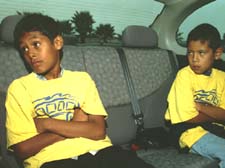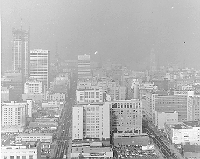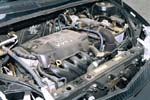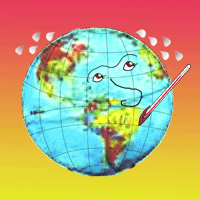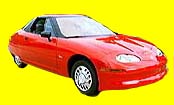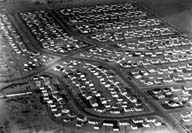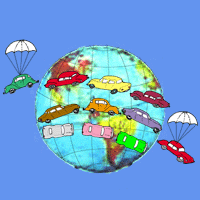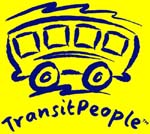
|
People like cars for a lot of reasons. Car drivers don't need to wait for trains or buses to pick them up, or transfer to another car to get where they want to go. It's easy for a car driver to stop at a shop on the way home from work, or to pick up a kid like you after school. In some places, car drivers can travel two or three times as fast as people using trains and buses.
Car drivers can go visit their friends late at night without having to walk back to the bus stop when it's dark and scary outside. They don't need to wait for a ride in the rain, and they always get their own seat. Sometimes trains and buses get crowded. Car drivers never need to stand up while they're riding, and they don't need to sit next to anyone they don't like. (Except maybe their little brothers!) And
finally, there are lots of places you can go in a
car that trains and buses don't go at all. If you
have a car, you can live on a twisty little road
that's But the trouble is, the popularity of cars is the main reason they cause so much trouble: there are too many of them!
One of the biggest problems cars cause is air pollution. An internal combustion engine uses fuel by mixing it with air and then burning it. When this happens, some exhaust gases are always left over. The exhaust gases go out the tailpipe and into the air. This isn't a problem if only a few people in a city drive cars; there's a lot of air! But what if millions of people are driving at the same time?
The answer is smog. Smog is what happens when the exhaust gases mix with sunlight. Sometimes you can see smog as a murky brown haze on the horizon. But smog is bad for you even if you can't see it. In Los Angeles, smog got so bad that the government started declaring "smog alerts." A "smog alert" happens when the air is unhealthy to breathe. Sometimes kids weren't even supposed to go outside to play. People complained that the smog made their eyes water, and that they couldn't see well enough to drive.
The smog made some people sick. Smog is especially bad for people who have problems with their lungs. Smog is one of the reasons that kids get asthma. But more and more people drove, and the smog got worse and worse. Finally,
the government passed laws that said that cars
couldn't make as much pollution. The car makers put
special controls on the new cars, so they Today a new car makes much less pollution than an old car. You'd need more than ten new cars to make as much smog as one 1968 Chevelle. The air in Los Angeles and some other cities is much cleaner than it used to be. In the 1970s, the government had to declare a smog alert in Los Angeles on almost every hot day. In 1998 there were only twelve smog alerts all year!
But smog is still a serious problem. It can hurt kids' lungs and cause heart attacks in adults. According to one study, the risk of cancer in Los Angeles is still hundreds of times higher than it would be if the air met government standards.
Another big problem partly caused by cars is global warming. The burning of fuel in all cars, even new ones that don't pollute very much, puts a gas called carbon dioxide in the air.
Carbon dioxide isn't pollution. Plants use it for photosynthesis. But the millions of cars, vans, trucks, motorcycles, buses, factories and powerplants running all over the world are making much more carbon dioxide than would be in the air normally. The extra carbon dioxide helps trap the sun's heat on earth. The whole planet is heating up because of it. A few scientists say that global warming isn't a big problem. But most think it's very serious. Global warming may cause shortages of food and water in some places. It may make the polar icecaps melt, and the sea level rise. One study said that average temperatures could be as much as eleven degrees higher by the end of the century. No one really knows how the world will change if people make it hotter.
Some new cars don't make any exhaust gases. These are electric cars. Electric cars have big batteries instead of engines. Have you ever recharged an electric toy by plugging it into a wall outlet? That's how electric cars are recharged!
Electric cars are a big improvement over regular cars! Unfortunately, they still make some pollution. The electricity to recharge them comes from powerplants. Powerplants are like factories that make energy for a whole city. A few powerplants make energy from the wind or sun, but most don't. Most powerplants make energy by burning coal or oil ... which makes more pollution!
The Union of Concerned Scientists wrote a book about how people can help the environment. They say that the most harmful activity is the use of cars and light trucks.
Cars use up a lot of space. In some cities, up to thirty percent of the land is taken up just by parking! Cars use freeways for fast driving, regular roads for slower driving, parking lots and parking garages and private garages built into homes. In an average city, every car has an average of eight parking spaces.
The next time you walk to school, look around your neighborhood at all the space cars use. I'll bet it's a lot! One reason kids in some cities don't ride bikes very much is that there are so many cars. Parents worry that the cars will hit their kids. Cars also get in traffic jams. A traffic jam is what happens when lots of drivers want to use the same road at the same time. There isn't enough room for them, so all the cars have to go very slowly.
Some people don't think that this is the cars' fault. They think it's the government's fault! They think the government should build more roads, so the cars would have room! But researchers have found out that something funny happens when the government builds more roads: people drive on them! Whenever a new motorway opens or a popular road is widened, people usually take more trips and do more driving. And the extra trips and driving cause more traffic jams!
In a lot of places there just isn't any more room for new roads, even if the government wanted to build them. In Los Angeles, for instance, most of the freeways were built between 1950 and 1970, when four to six million people lived in the county. Now almost ten million people live there, and the freeways are crowded! But where in Los Angeles is there room for a new one?
Some people try to get away from traffic jams by moving to the suburbs. A suburb is a community that's close to a city, but not really part of it. The adults can go into the city to their jobs, but live in a place that feels more like a small town. Suburbs
start when the government gives permission for
homes to be built on undeveloped land. Roads are
put in, and water, sewage and electric lines.
Supermarkets, hardware stores and other businesses
move in to sell things to the people who buy
Some suburbs are really nice! A lot of times they're prettier, cleaner and quieter than most cities. And there's less traffic!
For awhile. But what happens when the new suburb is full? More homes and roads are built, and more people move in, and more stores open to sell them things. Now all the new people are driving on the brand new roads, and on the roads of the first suburb, and on the roads of the city that the suburbs are built around. And then what happens if more homes, roads, people and stores move in after that?
This is called sprawl. Sprawl is one of the reasons there are so many traffic jams. Most of the new suburbs aren't built for public transportation. People who live there need cars to get around. Just between 1975 and 1990, the total number of miles that Americans drove their vehicles increased by over fifty percent! What will happen if people keep driving more and more? The government says that traffic in Los Angeles will get twice as bad by 2015, if things don't change. But the city of Los Angeles alone already has more cars than the poorest sixty percent of the people in the entire world!
And what will happen when all the people in the poor countries can afford cars too? Right now only eight percent of the world's people own cars. Cars are used mostly in the richer countries. If there were 750 cars for every 1,000 people, as there are in the United States, there would be four and a half billion cars on the earth, all taking up space and making pollution. And the world's population is going to get a lot higher!
There are other problems with cars. Some people can't see well enough to drive, or have other problems that prevent them from driving. Some don't like cars because they cost lots of money. Cars are expensive to buy, and the owners need to pay for insurance and gas. When the cars break, the owners need to pay for repairs, too. Recently, public transit has started to get more popular. More people are using it all over the country, especially in New York. Some people are very tired of air pollution, sprawl and traffic jams. Maybe more people are ready for a change.
|
